#church of england
Text
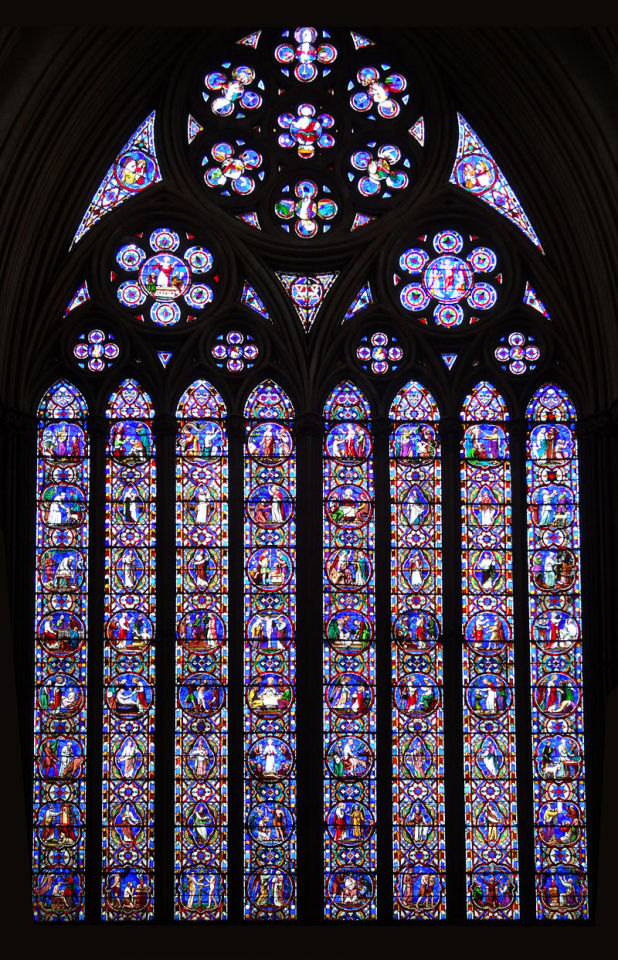
Like York Minster, Lincoln Cathedral also has a Great East Window
#Lincoln Cathedral#Great East Window#English cathedrals#UK#stained glass#mediaeval#sacred space#Church of England#Lincolnshire#13th century#religious art#Gothic architecture
312 notes
·
View notes
Text
Best WLW News Stories of 2023

Meet South Korea’s first lesbian couple to have a child
#hong kong#ohio#baldur's gate 3#andorra#church of england#nepal#latvia#estonia#pope francis#lesbian#gay#lgbt#lgbtq#wlw#bi#girls who like girls#lgbtqia#sapphic#news#2023#new year#south korea#Christmas
119 notes
·
View notes
Text
“The Church of England has issued a statement saying they will not allow same sex couples to marry in their church, and that marriage is between one man and one woman for life”
Putting the homophobia in 2023 aside for a sec, what kind of drugs are the Church of England on??
Besties you literally only exist bc the Andrew Tate of Tudor times wanted to divorce his wife!! Your basic principles of existence are based on being allowed to discontinue a marriage!!
690 notes
·
View notes
Text
The Church of England has released wording of a suggested prayer, which can be used in full or adapted by churches or people individually. The Prayer for HRH the Princess of Wales reads:
“Gracious God. We pray for the continued recovery of the Princess of Wales, for her husband, and for their family.
Grant to them, and to all who are affected by sickness, faith, hope, and knowledge of your love, through Jesus Christ our Lord. Amen.”
55 notes
·
View notes
Text
The Church of England was created because HenryVIII knew Mary wasn’t a son

#Church of England#define woman#Eve was a woman#Men trying to look progressive#HenryVIII#Mary the First was a woman#ann Boleyn lost her head because she was a woman who gave birth to a daughter#Jane Seymour died because she was a woman who gave birth#Catherine Howard lost her head because men abused her
1K notes
·
View notes
Text
Just when I think I couldn't love Sandi Toksvig any more...

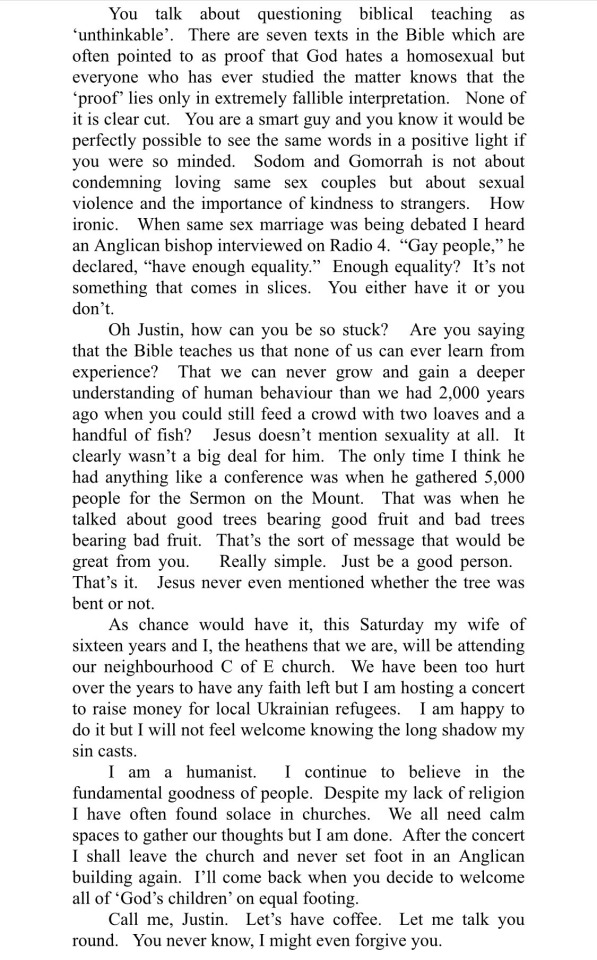
782 notes
·
View notes
Text
DC Comics Incorrect Quotes Pt 157
Harley: Respect the LGBTQ, or we will cook you.
Ivy, holding a pan: It's not just a rhyme, it's a threat.
Selina: It's no sin to shoplift, as long as the victim is a big supermarket. Jesus said "love thy neighbor," he didn't say "love Marks and Spencers."
Dick: I made this friendship bracelet for you.
Damian: You know, I'm not really a jewelry person.
Dick: You don't have to wear it.
Damian: No, I'm gonna wear it forever. Fuck off.
#dc incorrect quotes#tiktok#funny tiktok#kermit the frog#church of england#bobs burgers#dc#dc comics#comics#harley quinn#dr harleen quinzel#poison ivy#dr pamela isley#selina kyle#catwoman#dick grayson#nightwing#damian wayne#robin#gotham city sirens#batfam#batfamily#batkids#batbros#character dynamics#funny#lgbtq+#canon queer characters#comic books#harlivy
69 notes
·
View notes
Text
Ultimately, Protestantism's biggest failure is its blindness to history.
It presents a view of Christian history in which nobody had the truth, until it was discovered by Jean Calvin, by John Knox, by Huldrych Zwingli.
In denying the faith that the catholic, orthodox church had professed before the reformation, it denies that the Holy Spirit guides his church.
Did our Lord say 'I am with you evermore', or did he say 'I am not with you until 1517'?
As Newman said, 'To be deep in history is to cease to be Protestant'.
Return to the faith of your ancestors!
#anglican#anglocatholic#catholic#catholicism#orthodox#church of england#eastern orthodoxy#orthodoxy#Christian#Christianity
20 notes
·
View notes
Text
47 notes
·
View notes
Video
try this simple trick to annull your marriage! cardinals HATE him!
#video#tiktok#tiktoks#funny#lmao#wtf#history#king henry viii#religion#catholicism#christianity#church of england#oreugene
102 notes
·
View notes
Text




✞ how to be ‘that christian girl’
go for prayer walks
get involved with your church
Bible before your phone
pray when you wake up and before going to sleep
listen to worship music
eat healthily
prayer journal
Bible study
exercise
make christian friends
help others
be kind to everyone
give to those in need
I hope this helps! I am still quite new in my faith, but this has helped me, and if i can help just one person that will make me happy! God bless you!💗




#christian girl#that christian girl#bible study#healthy eating#self care#studying#i would love some christian mutuals#christianity#christian living#wish i had christian friends to do this with#bible scripture#bible verse#bibledaily#godisgood#helpingothers#christian friends#godly community#godly relationships#godly friends#sunday#church of england#church#exercise#healthylifestyle#healthyfood#wellness girlie#wellness#working out#your body is a temple#honour the lord
14 notes
·
View notes
Text
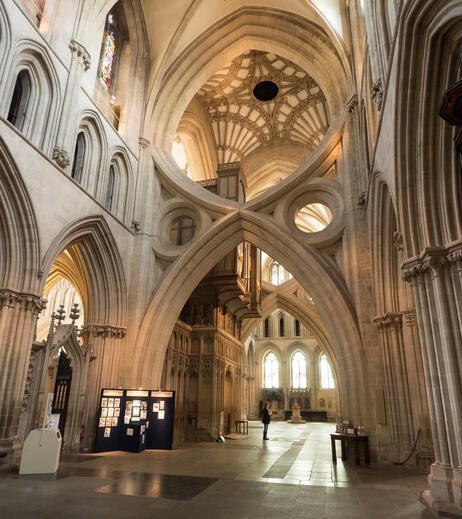

More views of the unique inverted arches supporting Wells Cathedral
#Wells Cathedral#Somerset#inverted arches#fan vaulting#architecture#mediaeval#Church of England#scissor arches#sacred space#perpendicular#Gothic#English cathedrals#UK
360 notes
·
View notes
Link
They are in nearly every village, town and city across the UK, thousands of church buildings peppering the landscape. But while many may no longer be in regular use, the churchyards surrounding them – quiet, peaceful and often ancient – amount to what Olivia Graham, the bishop of Reading, equates to “a small national park.” The land beyond the church gate is some of the most biodiverse in the UK because it has largely stayed untouched.
“A churchyard is a little snapshot of how the countryside used to be,” says Somerset Wildlife Trust’s Pippa Rayner, who is working on Wilder Churches, a new initiative with the diocese of Bath and Wells “to enhance churchyard biodiversity across the county...”
Wilder Churches is one of several schemes that have launched across the UK with the aim of maximizing biodiversity in churchyards. David Curry leads the Living Churchyards project in south-west England, a voluntary scheme that advises local clerics on how to use the land surrounding their church for the benefit of nature...
“Wildlife, as well as needing to feed, needs to hide, shelter and nest. Churchyards offer loads of opportunities for that,” says Rayner. “They are brilliant for lots of different things: it could be birds, lots of lesser-known plants, things like lichens, mosses and liverworts, which are sort of pioneer species that will grow on stones and gravelly areas associated with a churchyard. It’s a fantastic place for bees and butterflies, but also for the less noticeable small mammals, which in turn provide food for birds of prey and owls.”
“Churchyards are some of the least polluted lands around,” says Andy Atkins, chief executive of A Rocha UK, a Christian conservation charity whose “eco-church” programme rewards churches for taking positive actions for climate and nature. Last year, it saw the highest number of sign-ups for the programme in its six-year history, with 10% of churches in England and Wales now pledging their commitment to the scheme.
St James’s Piccadilly in central London is a gold standard eco church, in part due to its efforts in promoting biodiversity in an urban space. Deborah Colvin, one of the churchwardens, says they are hopeful their churchyard can provide a green link in a concrete landscape. “Let’s have hedgehogs going overground from Regent’s Park to the river,” says Colvin. “It’s a joke, but if you start thinking like that, then what would you put in place? The sort of work that you might do in this environment … is about linkages, corridors...”
Despite a growing appreciation for how nature-rich churchyards can be, many believe there is further potential to be unlocked in the ground between the gravestones. “There is great scope within our churchyards for managing the ground so that you increase the species of plants,” says Graham Usher, bishop of Norwich and the Church of England’s lead bishop on the environment. “You can put up bug hotels, bat boxes and bird boxes; there are lots of ways that you can really make your churchyard a much more biodiverse and attractive place.”
Curry believes that the single greatest change that can be made is a more enlightened system of grass mowing. “We go into these churches to improve the biodiversity, and the first thing I ask is: ‘How often do you cut your grass?’ Then the vicar moans about spending £1,200 a year on cutting the flipping grass,” he says. “I tell them to stop cutting the grass – just cut it four times a year, at the right time. It doesn’t need to be manicured.”
As communities become increasingly involved in initiatives such as Wilder Churches, it is hoped, they too, will benefit from the boost to biodiversity.
“There is an intrinsic value to nature, and having churchyards which are thriving with nature means that they can be spaces where those who live in the community can delight in what they see, what they smell and what they hear,” says Usher. “We want to remember that churches are not places of the dead but places of the living. There is a real drive for this from members of communities and congregations who are passionate about the environment and want to support these efforts.”
Beyond the churchyards, religious institutions are increasingly calling for world leaders to take action for the climate and nature. The Church of England has pledged to reach net zero emissions by 2030. With the support of A Rocha UK, more than 2,200 churches in England and Wales ran “Climate Sunday” sermons in the lead up to Cop26.” -via Reasons to Be Cheerful, 10/31/22
#conservation#graveyard#church of england#england#wales#biodiversity#rewilding#community engagement#churchyard#bug hotels#bird boxes#christianity
126 notes
·
View notes
Text
An Act whereby the Queen's Highness Elizabeth is restored in Blood to the late Queen Anne Boleyn, her Highness's Mother, 1558
In her first parliament on the 5th of December, 1558, Queen Elizabeth I restored The Act of Supremacy declaring her as Supreme Governor of the Church of England which brought some doubts into the spotlight, especially regarding her rights to the throne.
Now, the matter of her legitimacy was and always remained unclarified since her mother, Anne Boleyn, was found guilty and executed. The Church of England and an act of Parliament declared her marriage to Henry VIII null and void in 1536 the night before her execution, so she died a marchioness [of Pembroke]. Henry VIII, all his life after May 1536, declared his marriage to Anne was invalid, and when Queen Kateryn Parr convinced Henry to add Mary and Elizabeth to the succession it was with the condition that they marry someone vetoed by the majority of Prince Edward's appointed Privy Council, and as we know, after Edward died and the Earl of Northumberland's rebellion was put down Queen Mary rose to the throne and the conditions of said will was unattainable (referring as to the support of the majority of the PC), all that was left was a clear line of succession:
"As to the succession of the Crown, it shall go to Prince Edward and the heirs of his body. In default, to Henry's children by his present wife, Queen Catharine, or any future wife. In default, to his daughter Mary and the heirs of her body, upon condition that she shall not marry without the written and sealed consent of a majority of the surviving members of the Privy Council appointed by him to his son Prince Edward. In default, to his daughter Elizabeth upon like condition. In default, to the heirs of the body of Lady Frances, eldest daughter of his late sister the French Queen. In default, to those of Lady Elyanore, second daughter of the said French Queen. And in default, to his right heirs. Either Mary or Elizabeth, failing to observe the conditions aforesaid, shall forfeit all right to the succession."
-https://www.tudorsociety.com/30-december-1546-henry-viiis-will/
So, after attaining her crown through the strength of arms and said will, Queen Mary undid the Act of Supremacy of 1534, brought back the powers of Rome, and with their support made the marriage of her father and Katharine of Aragon legal and the Church of England heretical, thus Elizabeth was doubly the bastard.
After Queen Mary's death and Queen Elizabeth's accession, following the order of the will, the binds with Rome were severed this time and the laws and acts passed by Queen Mary regarding this were repelled, thus leaving Katharine of Aragon again with the title of Dowager Princess of Wales (as to her marriage to Prince Arthur, Henry VIII's older brother) and the Church of England reinstated, which came with the mere fact that twenty-one years ago it declared the marriage of her parents null and void. But she couldn't simply overturn a decision made by the King, her sire which gave her the claim to the throne without undermining the power of kings, and there was also the fact that her mother was a convicted felon for which by the relation of blood in the English law of yore made one unfit to receive high titles, but of course, the majority of people, protestants and such, wanted her and thought her fit.
So Queen Elizabeth can't openly make the marriage of her parents legal without undermining the CoE nor make the charges against her mother be posthumously dropped without undermining her new office and late father, but what she can do is make herself the daughter of a true Queen of England which had her name marred unjustly, she can't change the law and edicts but she can change the people's perception of who is right, so thus:
"Elizabeth I reinstated her mother Anne Boleyn as a Queen, as Anne had been stripped of her titles during her trial. This would have reinforced Elizabeth's right to the throne and perhaps been important to the new queen privately"
-https://ukparliament.shorthandstories.com/succession/
As the head of the protestants in the nation, the idea that she was the daughter of a martyr of religious freedom was spread and made her a beacon of hope, the way people viewed Queen Anne back then would have been of a woman wronged who's favor and righteousness God showed by the daughter that would save them from the inquisition. Excellent PR if you ask me.

Parliamentary Archives, an edict that restores the title of Queen to Anne Boleyn (if anyone can read and make a transcript it would be amazing) HL/PO/PU/1/1558/1Eliz1n21
#history#anne boleyn#elizabeth i#elizabeth tudor#england#mary i#katherine of aragon#henry viii#tudor dynasty#tudor period#tudor history#catherine parr#accession#parliament#church of england#edward vi
52 notes
·
View notes
Text
Anonymous asked: I read your post on the philosophical defence of monarchy and I’m impressed with the way you mounted such a formidable argument in favour of it. The flaw in your argument is how old you portray the monarchy’s ancient origins to lend legitimacy to its rule. How can you say the rituals and traditions of the British monarchy are ancient if the coronation itself took place in an Anglican church after the Reformation? That makes it a modern invention not ancient. Your fancy intellectualizing is built on a house of cards.
Thank you for at least reading my post even if you haven’t quite understood what I did write. The flaw in your reasoning is to conflate the British monarchy with the the tumultuous changes of the Reformation in England alongside the establishment of the sovereign as the head of the Church of Engand.
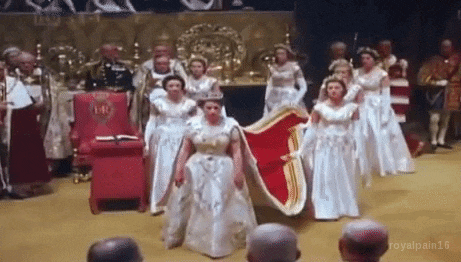
The coronation of a new monarch in the Anglican church had not been going on since the Reformation but goes back even further before the Reformation. Your mistake is to wrongly date the Anglican church. People forget this but the Church of England was established by St Augustine of Canterbury in 597 CE.
Almost nothing is known of the early life of the man who brought Christianity to medieval England. Augustine was most likely living as a monk in Rome when in 595, Pope Gregory the Great chose him to lead a mission to convert the pagan Anglo-Saxons to the Christian faith. Christianity had been present in England during Roman times, but with the arrival of the Saxons, most of the country had once again reverted to paganism.
England in the 6th century was divided into many warring kingdoms. Of these, it was Kent that was chosen as the place to begin Augustine’s mission in England, most likely because of the powerful position of its ruler, King Æthelberht.
The story of St Augustine’s arrival in England has become the stuff of legend, and was first told by the 8th-century monk and historian Bede, writing 140 years after the events took place. Bede describes how when Augustine arrived in Kent, Æthelberht met the monk and his 40 companions outdoors, because the pagan king was scared of the new arrivals practising sorcery.
The monks are said to have held up a silver cross and a panel painted with the image of Christ. We are told that King Æthelberht, while wary of his visitors, did allow them to preach to the gathering.
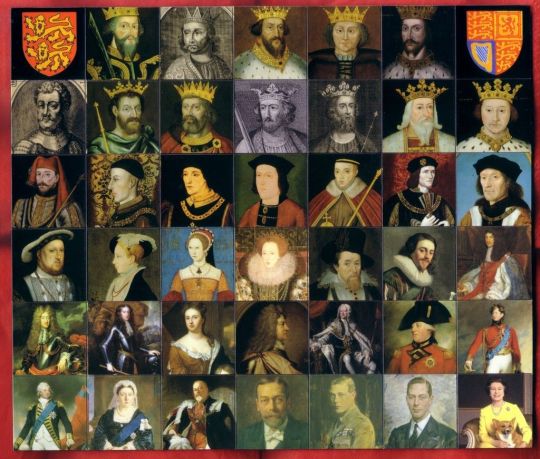
King Æthelberht was most likely accompanied by his wife, Queen Bertha. Bertha was a Frankish princess who was already a Christian, despite her marriage to a pagan king. It is thought that the presence of Bertha may have been another reason for Augustine to begin his mission in Kent. She is known to have been in contact with the Pope around this time, and the fact that her husband allowed her to practise Christianity perhaps suggested that he might also be sympathetic to Augustine’s mission.
King Æthelberht did not immediately convert to Christianity, but he did treat Augustine and his companions with hospitality. They were given freedom to preach and invited to reside in Canterbury, the capital of Kent. Augustine and his companions held services in the ancient church of St Martin’s, which is believed to be the church that Queen Bertha herself worshipped in.
Eventually, King Æthelberht did convert, and the abbey of St Peter and Paul (later rededicated to St Augustine) was founded in Canterbury in about 598. Augustine became the first Archbishop of Canterbury, a role that to this day is still the most senior cleric in the Church of England.
There were many advantages for Augustine in gaining royal support for his mission. King Æthelbert’s gifts enabled the creation of a school and a library at the abbey, which in turn established it as an important seat of learning. Pope Gregory even sent books from Rome to fill the abbey’s bookshelves.
Æthelberht also provided protection to the new Christian church. He made laws that protected church property and punished transgressions against the Church even more harshly than those against the Crown. These charters may have been drawn up under the guidance of Augustine himself. Augustine was clearly a shrewd man who knew that royal support was essential if his mission was to be successful.
It is known that Augustine died on 26 May, though scholars still argue over whether the year was 604 or perhaps 609. Christianity continued to spread throughout the other English kingdoms in the years that followed St Augustine’s first mission, but its progression was not smooth. Not all of the successors to the converted Anglo-Saxon kings were Christian, including some of those that followed Æthelberht in Kent. The Christianisation of the Anglo-Saxon kingdoms was finally completed at the end of the 7th century, when the Isle of Wight’s last pagan king, Aruald, died in 686.
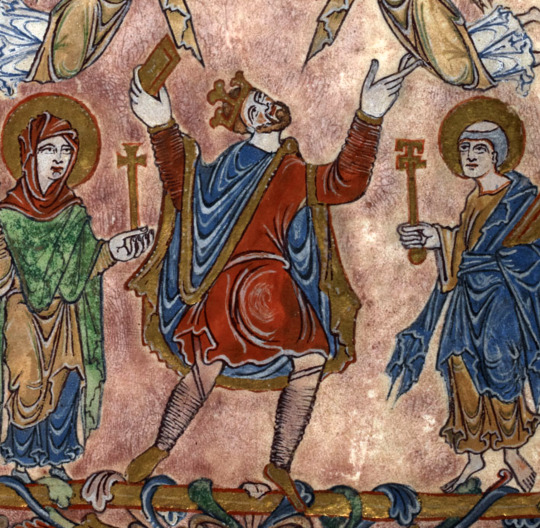
It was Edgar (known as King Edgar the Peaceful) who became the first king to be coronated under the sacred auspices of the Church of England. When he was coronated in 973, this was the first time a king was coronated as king of England. When his uncle Aethelstan had united the various kingdoms of Wessex, Mercia, Northumbria, and East Anglia, this was achieved over time, whereas Edgar came to power as King of a united England.
His coronation as King of England has become the model for coronations, and the oath he gave at his coronation in 973 is the oath still given by British monarchs upon their coronations. The oath required the king to carry out three duties: first, to protect the church and the peace of the land; second, to establish the rule of law and forbid criminally in all classes of subjects, even the nobles; and third, to use justice and mercy in all judgments, which is to say, to be impartial, fair, and not vindictive or cruel, nor to show favoritism or let friends off easily.
Edgar consolidated the unity of England established by his uncle (his father’s much-older half-brother) Aethelstan the Glorious (ruled 924-940) so that England never afterwards experienced a long-term division back into the minor kingdoms (of York, Northumbria, Mercia, Wessex, East Anglia, etc.)
Edgar, lest we forget, was a great-grandson of Alfred the Great. Edgar was the father of Edward the Martyr (ruled 975-978) and Aethelred The Badly-Counseled (“Aethelred the Unready”, who ruled 978-1016). He was thus the grandfather of Edmund Ironside (ruled 1016) and Edward the Confessor (ruled 1042-1066). And then we get to William the Conqueror and 1066 and all that...
So in effect all that happened at the Reformation under Henry VIII is that the Church of England declared its independence from the Pope; its internal administrative structure remained the same.
Freed from Papal control, the Anglican Church went on to diverge in doctrine as well over the following years, though not as much as most other Protestant churches.
The coronation ceremony for British monarchs based on the rites first used to crown King Edgar in the year 973 continued to be used after Henry VIII’s time.


The modern ceremony is not identical, of course; for one thing, it’s in modern English not Anglo-Saxon or Latin. However, each new version of the ceremony to crown a new monarch was based on the previous ceremony, in a direct chain of evolution.
The liturgy described in the Liber Regalis, written in the 14th century and itself based on earlier precedent, is still regarded as definitive. The mediaeval manuscript is kept in Westminster Abbey, the Anglican cathedral where most new monarchs have been crowned ever since 1066.
Interestingly, James VI of Scotland had the Liber Regalis translated into English for his own coronation in England in 1603, and subsequent coronations have drawn from it as their basis: though with variations and changes to suit their particular requirements. In the 20th century there was a movement to bring back more elements of the more ‘authentic’ early ceremony.
A ceremony which was first performed 1045 years ago and still follows the same basic format today surely qualifies as ‘ancient’ by most standards and doesn’t need ‘fancy intellectualising’.

Thanks for your question.
#ask#question#monarchy#edgar#king edgar#coronation#royalty#church of england#anglican church#catholic church#reformation#society#history#st augustine#canterbury#england
71 notes
·
View notes
Text
Majority of Church of England priests support same-sex weddings
A survey of Church of England clergy by The Times newspaper has found widespread support for a change in rules to allow priests to conduct same-sex weddings.
The survey of 1,200 serving priests found that over half (53.4%) support a change in Church law to allow them to wed gay couples, compared to over a third (36.5%) who are opposed.
The Church of England's parliamentary body, the General Synod, backed plans to introduce same-sex blessings in February. Asked where they stand on the issue, most of the priests surveyed (59%) said they plan to offer same-sex blessings to couples, versus 32.3% who said they will not.
#church of england#same sex marriage#politics#lesbian#gay#lgbt#lgbtq#wlw#bi#girls who like girls#lgbtqia#sapphic
20 notes
·
View notes